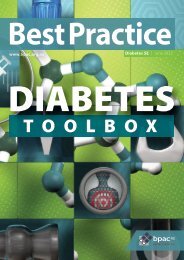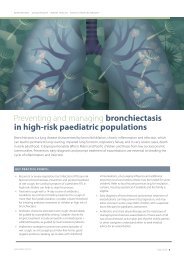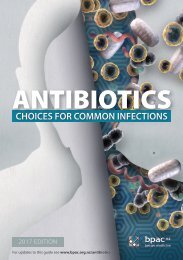Create successful ePaper yourself
Turn your PDF publications into a flip-book with our unique Google optimized e-Paper software.
Early onset results in worse health outcomes<br />
Younger people diagnosed with type 2 diabetes, e.g. before<br />
the age of 40 years, have a higher risk of early mortality,<br />
cardiovascular disease, chronic kidney disease and retinopathy<br />
than older adults diagnosed with type 2 diabetes or people<br />
with type 1 diabetes at a similar age. 4–6 This is largely because<br />
people diagnosed younger have diabetes for longer and are<br />
therefore exposed to more risk, but also because glycaemic<br />
control tends to be worse and younger people are more likely<br />
to have sporadic contact with health care services. 4, 7<br />
Test people at high risk<br />
HbA 1c<br />
should be tested in people at high risk of type 2<br />
diabetes of any age to aid early detection and therefore reduce<br />
their risk of future cardiovascular and renal complications. As<br />
type 2 diabetes is not necessarily associated with any symptoms,<br />
patients may not even recognise that they are at risk.<br />
Identifying people at elevated risk<br />
Ministry of Health guidelines recommend HbA 1c<br />
testing in<br />
people with any of the following risk factors: 2<br />
A BMI of ≥ 27 kg/m 2 for people of Māori, Pacific or South<br />
Asian ethnicities, or ≥ 30 kg/m 2 for people of other<br />
ethnicities *<br />
A first-degree relative who developed type 2 diabetes at<br />
an early age, e.g. < 40 years<br />
Long-term use of oral corticosteroids<br />
Females with a personal history of gestational diabetes<br />
Females with polycystic ovary syndrome<br />
Severe mental illness, particularly those on long-term<br />
antipsychotic treatment<br />
Known ischaemic heart, cerebrovascular or peripheral<br />
vascular disease<br />
Children and adole<strong>sce</strong>nts (aged > 10 years or at onset of<br />
puberty, whichever occurs earlier) who are overweight or obese<br />
(BMI ≥ 85th percentile or BMI ≥ 95th percentile, respectively)<br />
should be tested if there is a family history of early onset type 2<br />
diabetes, a maternal history of diabetes or gestational diabetes,<br />
or if they are of Māori, Pacific or Indian ethnicity. 2, 8<br />
* A lower BMI threshold is recommended for people of Māori, Pacific or<br />
South Asian ethnicities due to the higher risk people of these ethnicities<br />
have of developing type 2 diabetes. 2 South Asian ethnicities include<br />
Indian, Fijian Indian, Sri Lankan, Afghani, Bangladeshi, Nepalese, Pakistani<br />
and Tibetan.<br />
A specific opportunity to incorporate HbA 1c<br />
testing into routine<br />
practice is the cardiovascular risk assessment; the age at which<br />
to start assessments is now recommended as: 9<br />
45 years for males and 55 years for females with no<br />
known risk factors<br />
30 years for males and 40 years for females of Māori,<br />
Pacific or South Asian ethnicity<br />
35 years for males and 45 years for females with known<br />
cardiovascular risk factors or at high risk of developing<br />
diabetes †<br />
† Further information on family and personal risk factors<br />
is available at: www.health.govt.nz/publication/<br />
cardiovascular-disease-risk-assessment-and-management-primary-care<br />
Consider the possibility of type 1 diabetes or a monogenic<br />
form of diabetes in younger adults with elevated HbA 1c<br />
without obesity, family history or other typical features such<br />
as hypertension, dyslipidaemia or non-alcoholic fatty liver<br />
disease.<br />
Lifestyle change is a cornerstone of<br />
managing and reducing the risk of type 2<br />
diabetes<br />
One of the most important points to convey to people who<br />
have type 2 diabetes or pre-diabetes is that the course is<br />
modifiable. Changes to their lifestyle, i.e. ensuring a healthy,<br />
balanced diet and engaging in regular physical exercise, may<br />
be difficult at first, but they can substantially improve their<br />
future health. The patient will have to take the lead role in<br />
making those changes, but with support from their primary<br />
care team. Setting small, incremental goals can be helpful if<br />
patients are feeling overwhelmed by the extent of changes<br />
recommended. 10<br />
Weight loss has the potential to induce remission of type 2<br />
diabetes in people who are overweight or obese, i.e. to achieve<br />
an HbA 1c<br />
< 50 mmol/mol without the use of medicines, 11 and<br />
should be regarded as a core focus of treatment.<br />
For further information on weight loss, see: www.bpac.org.<br />
nz/2019/weight-loss.aspx<br />
Lifestyle change in people with pre-diabetes reduces their<br />
chance of developing diabetes by approximately 50–60%<br />
over three years and 27% over 15 years. 12, 13 This includes<br />
aiming for a 7% weight loss, 2.5 hours per week of moderate<br />
intensity physical activity and following healthy diet<br />
recommendations.<br />
Referral for bariatric surgery may be appropriate for some<br />
people with a BMI between 35–55 kg/m 2 to assist with weight<br />
loss. 10 Bariatric surgery can reduce the likelihood of developing<br />
type 2 diabetes, and in those who already have type 2 diabetes,<br />
can induce remission, as well as reduce the risk of diabetes<br />
10, 14<br />
complications, cardiovascular disease and some cancers.<br />
For further information on bariatric surgery, see: www.<br />
bpac.org.nz/2018/diabetes.aspx#bariatric<br />
www.bpac.org.nz<br />
Best Practice Journal – SCE Issue 1 9









